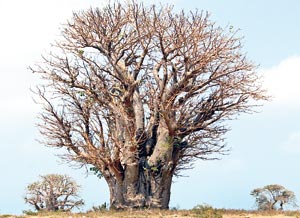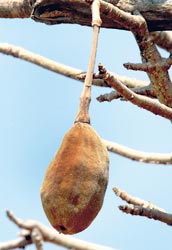The landscape is starkly beautiful. The lagoon has receded due to the drought, leaving a wide expanse of white sand spreading as far as the eye can see.
The sands are dotted with scrubs and pools of lagoon water struggling for survival against evaporation from the scorching rays of the sun. These pools are embroidered with what seems like an edge of white lace set with diamonds, shimmering and sparkling in the sun -- only a closer look revealing salt crystals, formed with no human intervention.
We are on the Mannar-Talaimannar Road, with hardly a human around. The only creatures that have braved the heat to be on the sandy plains are herds of cattle and a couple of donkeys scattered here and there, in search of water.
 |
| Baobabs: Unusual sight against a stark background. |
Suddenly, the eye falls on a strange sight – giant sentinels, in forbidding stance as if to ward off any invader who dares to step on Mannar island.
The sight of the extraordinary and legendary Baobab trees leaves one amazed and rouses instant curiosity. Having not seen them anywhere else in the country, the information board by the giant -- with a circumference of 19.51 metres and height of 7.5 metres – in Pallimunai, leads one down the misty corridors of time.
This Baobab tree, now maintained by St. Lucia’s Church Committee of Pallimunai, is believed to have been planted by Arabian sailors, over 500 years ago, way back in 1477.
Those were the times when, strategically-located Serendib, as we were known, would not only have been a trading hub but also the lure for various visitors, both from the west and the east.
Did Arabian sailors plant the Baobab? Or did they just bring some of its fleshy fruit, said to be rich in Calcium, in the days when refrigeration was unknown, and chew on them while trading or repairing their vessels in Mannar and throw the seeds away, oblivious of the legacy they would have left behind? Many are the interesting facts that emerged when researching about the Baobabs which are of the Adansonia species in the botanical family of Bombacaceae. The tree had been named Adansonia to commemorate the pioneering French naturalist and botanist Michel Adanson (1727-1806) who was also a surgeon, who did much work on the Baobabs and also attempted to age them.
There are a total of eight species growing in tropical, semi-arid regions, with Adansonia digitata being widespread in Africa, six other species being endemic to Madagascar and one — Adansonia gregorii — growing in Australia where it is known as the Baob, it is learnt. Of these, the six Madagascan species are threatened, according to the IUCN Red List 2009. Incidentally, there is said to be a spectacular ‘Avenue of Baobabs’ near Morodava in Madagascar.
 |
| The fleshy fruit |
The Baobab is sometimes called the “upside-down tree” because its branches, when sans leaves, look like roots sticking up into the air or the “bottle tree” as its trunk swells up after storing water.
This is the very feature – storage of water in the vast and bulbous stem -- which makes it a hardy survivor, able to endure the arid climate. Those found in Australia are believed to live over 2,000 years.
Meanwhile, Adansonia digitata, the type of Baobab found in Africa which seems to bear the closest resemblance to the giants of Mannar had derived its name due to its leaves, of which each has five to seven leaflets that look like fingers (digits).
The large white sweet-scented flowers are pollinated by nocturnal animals. For digitata, it is mostly bats and for different Madagascan species, lemurs, fruit bats and hawk moths.
Many are the benefits of the Baobab, research reveals, with Kalahari bushmen quenching their thirst by sucking water from the trunk through the hollow stems of grasses; the fibre from the trunk being made into rope or woven to make cloth; the fruits, the young shoots and leaves being edible; and the bark, leaves and fruit being used in African traditional medicine. The extract of the Baobab bark is used to treat sickle cell anaemia, it is understood.
Back in Mannar, sadly, some of the mighty giants can be seen on their sides, with many wondering what has felled them and whether gradually the Baobabs are dying out here.
Can’t someone save the Baobabs which are a symbol of Mannar, is the question being asked. Otherwise this gift from Africa may soon be limited only to photographs.
Baobab trivia
Many are the references to Baobabs, when doing an internet search:
- In the ‘Little Prince’ by Antoine de Saint Exupery, the prince keeps uprooting Baobabs for fear of the trees splitting his small planet into pieces.
- In the ‘Lion King’ Rafiki makes his home in a Baobab.
- In ‘The History of Creation’, Ernst Haeckel mentions that the “monkey bread-fruit trees” (another name for the Baobabs) have an individual life exceeding a period of 5,000 years.
- The owners of a farm in Limpopo, South Africa are said to have built the pub, ‘The Big Baobab Pub’ in the hollow trunk of a 22-metre (72-ft) high Baobab. This tree which is 47m (155ft) in circumference is reported to have been carbon-dated at over 6,000 years old.
|


